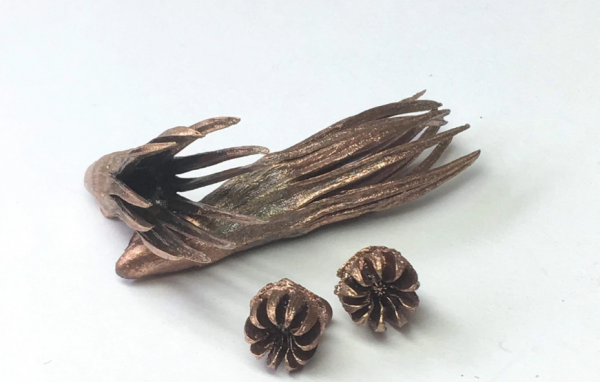While living in the past is inadvisable at best, our histories shape our present. It’s vital that we nurture our connection with the past and give it the respect it deserves, so that we may grow and learn from it. This is precisely what Horn Island (Torres Strait) artist Emily Beckley is seeking to achieve.
Honouring the Meriam Mer experiences, stories and history of her people, she moulds metal to her will, creating striking pieces of jewellery which blend traditional and contemporary elements. In effect, Emily is bringing traditional values and aesthetics into the 21st century, adapting them with love, respect and a cutting edge.
Emily is by trade a gifted painter, whose work, exhibited in the National Gallery of Australia, has recently been bought by UTS, Sydney. However, after attending a workshop by the Indigenous Jewellery Project (more on them in a bit), she has thrown herself wholeheartedly into jewellery design.
In November of 2018, Emily became the first indigenous artists in residence at the prestigious ANU School of Art and Design and held her first solo exhibition of contemporary jewellery at Craft ACTL Craft and Design Centre, Canberra. But what gives Emily her edge? What creates interest in her work? How is she making traditional arts and practices relevant in a contemporary context?
Traditional Torres Strait art is primarily concerned with the warrior’s way of life, emphasising traits and qualities revolving around martial masculinity. Emily is bringing her people’s art into the contemporary world by shifting her focus, and our focus, onto the usually unseen softer, more romantic side of her culture.
Her most striking pieces, and her projects which have attracted the most interest, revolve around her people’s bridal and celebratory traditions. Emily’s work on the Haddon Bridal Pendant, or sabagorar pendant, eventually led to her being interview by ABC TV News, while her series of Kulap seed pendants reference her own practice as a traditional dancer.
The Sabagorar pendant was traditionally carved from turtle shell and worn by brides. Collected by Alfred C Haddon in 1898, it’s been kept at the British Museum for 120 years. Thanks to Emily, the pendant has now been revived and recreated for the first time using contemporary metal jewellery practices.
Kulap seeds, on the other hand, were initially used by Torres Strait Islanders to make shakers, used in traditional dance. Emily’s Kulap seed pendants are woven with silk, silver and brass wire, in allusion to her history as a traditional dancer and of her people’s powerful bond with the sea.
In September this year, Emily will be bringing her works to Radiant Pavillion 2019, the largest biennale of Contemporary Jewellery in the Southern Hemisphere, Melbourne. Bringing lesser-known aspects of the Meriam Mer culture to the forefront, Emily highlights the depth and diversity of what was once perceived as a simplistic artistic tradition. She demonstrates powerfully that echoes of the past in the present, and the present in the past, are always to be found. It’s extremely poignant to see artistic traditions evolve and remain relevant, creating strong links between the past and the present.
It all began with a workshop by the Indigenous Jewellery Project. Created by McCulloch & McCulloch co-director Emily McCulloch Childs, IJP’s mission is to bring you “the world’s oldest continuous jewellery tradition, in a contemporary form.” Acting through research, workshops, film and exhibitions, IJP hopes to promote traditional jewellery artists through exhibitions and educational programmes, as well as the creation of a space for artists to further their creative practices.
The emphasis is on bringing traditional elements and contemporary crafts closer together, ensuring that cultural traditions remain relevant and respected.
Are you fascinated by this merging of the traditional and the contemporary? Check out Emily’s IJP exhibition at artisan gallery from the 21st of September, and inject yourself into this process of bridging the gap between past and present.
